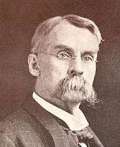Case III. Mrs. S., age 76, also an inmate of the Memorial Home came to my charge the same time as Mrs. F. She was dropsical and asthmatic. The urine was loaded with albumin, and, apparently, she was progressing to a fatal termination without interruption.
She took Arsenicum, Apis., Apocyn., Lachesis, with some relief. The latter seemed to give the only relief; finally, she was becoming very large; hands, face, limbs and abdomen all oedematous, while Lachesis afforded relief I had decided not to tap. Though she had taken medicine at proper intervals, when there seemed a demand for a repetition, yet the time came when she seemed to get no benefit from the remedy. The suffocation after sleep was the special symptom guiding to Lachesis 41m. was the preparation used. Early one morning I was advised as to her condition. She had suffered greatly during the night with pains in the feet and legs, and her feet were getting black. The matron thinking that she was about to die, gave her some whiskey without relief. The great pain in feet and legs, skin turning black, perhaps threatening gangrene. Arsenicum and Lachesis had failed, guided me to Tarentula cubensis, which was given, 12x one dose. The pain subsided immediately, the dark colour of the skin on legs became bright red and in a general way, she felt improved and got up. Next night, slept well until toward morning, when pain in lower limbs returned, Tarant. cub. 12x was repeated, with perfect relief. The medicine has been repeated by necessity about every day since November 20th.
December 1. There is now a fiery redness of the skin below the knee to the ankles on both legs, tender to the touch and covered with small blisters. Everybody that looked at it thought it was erysipelas. A serious transudation is going on from the surface of both limbs from the feet to about six inches above the knees, which runs down and drips from the heels and also saturates the absorbent dressings in a few minutes. A sheet placed on the limbs as an outer covering must be taken off every hour and another put on as the serum is so great in quantity. A sheet dried shows very little discolouration but is pungent to the smell. There has been no perspiration from any part of the body. The oedema appears to be going down.
December 15th. The oedema has gone from the face, hands and thighs. The abdomen has become nearly natural in size, and albumin has not been noticed in the urine since December 1. Urine has been very scanty. The legs are covered from knees to ankles with a profusion of flat ulcers which secrete a serous flow, and large yellow crusts are forming.
December 20. Oedema gone out of feet and ulcers are still flat with red, and in the places blue margins and red and bluish interspaces on the skin. Yellow scales are forming. The patient is somewhat prostrated, but says she is more comfortable with ulcers than with the “bloat” as she nearly suffocated before. Since December 1, she has had an occasional dose of the medicine, as the pain in the legs became severe.
January 1, 1883. She shows signs of sinking, though she says she is feeling comfortable except the occasional sharp pain in the ulcers.
It is evident she is going to die, but will she die of exhaustion or will the dropsy return and death occur as usual from such condition? Such was my query.
January 9. She died of exhaustion.


